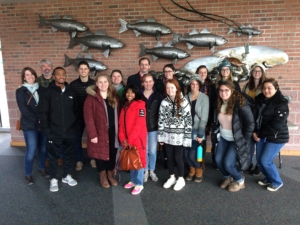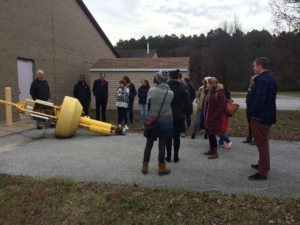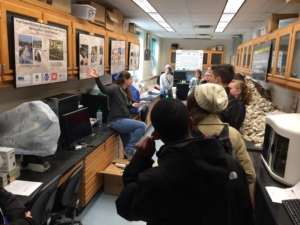Career Development News: CRC is now accepting applications for our 2019 summer Chesapeake Student Recruitment Early Advisement and Mentoring (C-StREAM) internship program. To learn more about the program and how to apply, click here!
Staffers Visit UMCES’s Horn Point Laboratory

CRC Staff had the opportunity to meet Horn Point Lab’s Dr. James Pierson and hear about his work studying climate impacts on plankton. Thank you, Dr. Pierson!
Over the course of a CRC Staffer’s three-year term in the Environmental Management Career Development Program, Staffers are busy coordinating their Chesapeake Bay Program partnership teams’ activities, providing support to team members, tracking progress, and documenting successes and lessons learned. The Chesapeake Bay Program’s partnership office is a fast-paced working environment and though the Staffers enjoy being an important part of the Bay Program’s story, they also like to take a break, slow things down, and have a little fun!
This winter, the Staffers joined the rest of the CRC Staff for a tour of one of CRC’s member institutions, the University of Maryland Center for Environmental Science’s Horn Point Laboratory. The Horn Point Laboratory is nestled along the banks of the Choptank River on Maryland’s Eastern Shore. The faculty, staff, and students of Horn Point Lab engage in research on the biology, chemistry, physics, and ecology of organisms and ecosystems from the wetlands and estuaries of the Chesapeake Bay to the continental shelf and the world’s oceans.

CRC Staff with tour guide Blake Clark outside the Morris Marine Lab learning about the monitoring equipment used by Horn Point Lab researchers. Thank you for a great tour, Blake!
Our tour began at the Coastal Sciences Building where we learned about the lab’s history, current research, and specific actions we can take to help support the Chesapeake Bay and its living resources to ensure their continued restoration. We then visited the Morris Marine Lab building where we were able to explore the physical oceanography department and the equipment used by researchers to establish an extensive record of the Bay’s water quality and physical conditions.
We ended our tour at the Horn Point Oyster Hatchery where we met with Stephanie Alexander, Horn Point Oyster Hatchery Manager and got a complete view of what it takes to spawn oysters for use in research, oyster restoration, and educational programs. The Horn Point Oyster Hatchery is one of the largest oyster hatcheries on the East Coast and have deployed over one billion oyster spat to Chesapeake Bay in the past decade.

CRC Staff with Hatchery Manager Stephanie Alexander learning about the hatchery’s operations. Thank you for showing us around, Stephanie!
If you have never visited Horn Point Laboratory’s beautiful campus, I encourage you to schedule a visit soon!
For additional information regarding CRC’s Environmental Management Career Development Program, please contact Melissa Fagan, Environmental Management Career Development Program Coordinator at faganm@chesapeake.org. Funding for CRC’s Environmental Management Career Development Program is provided through a cooperative agreement with the US EPA.
